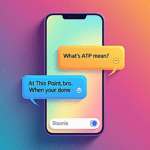If you spend any time on TikTok, Instagram, or texting with friends, you’ve likely seen the 👉👈 emoji combination pop up in comments, captions, or DMs. But what does 👉👈 mean, and why has it become such a staple in digital conversations? Whether you’re a parent trying to keep up with your kids’ lingo, or you’re just curious about the latest emoji trends, this guide from Slanginfo.com will break down the meaning, origins, and cultural context of this viral emoji gesture.
The Meaning of 👉👈
At its core, 👉👈 is used to express shyness, nervousness, or bashfulness—especially in a cute or endearing way. The two pointing finger emojis mimic a real-life gesture where someone touches their index fingers together, often while looking down or blushing. It’s a body language cue that signals someone is feeling timid, hesitant, or a little bit awkward.
In online chats and social media, 👉👈 often pops up in these situations:
- Flirting: When someone is trying to be cute or make a shy confession.
- Apologizing: Softening a request or saying sorry in a gentle way.
- Nervousness: Expressing uncertainty, hesitation, or vulnerability.
The emoji combo adds a layer of emotional nuance that plain text can’t always convey, making it a favorite among Gen Z and younger Millennials.
Origins and Evolution of 👉👈
The 👉👈 gesture has its roots in real-life body language, where touching index fingers together is a classic sign of shyness or embarrassment. This pose is often seen in anime, cartoons, and even in viral videos, making it instantly recognizable to many internet users.
As digital communication evolved, people began using the two finger-pointing emojis to recreate this gesture in text form. The trend took off on platforms like TikTok and Twitter, especially in fandom circles and among users who favor a “soft,” cute, or vulnerable style of communication.
Today, 👉👈 has become a universal symbol for bashful cuteness in online chats, memes, and even brand marketing targeting younger audiences.
How 👉👈 Is Used in Social Media and Messaging
The versatility of 👉👈 makes it perfect for a variety of digital scenarios. Here are some common ways you’ll see it used:
Flirting or Shy Confessions
- “I like you 👉👈”
- “Would you maybe wanna hang out sometime? 👉👈”
Apologizing or Making a Humble Request
- “Sorry I was late 👉👈”
- “Can you help me with my homework? 👉👈”
Expressing Nervousness or Hesitation
- “I don’t know if I should say this 👉👈 but…”
- “Is it okay if I join you guys? 👉👈”
Often, 👉👈 is paired with other emojis like 🥺 (pleading face), 🙈 (see-no-evil monkey), or even a blushing emoji to enhance the overall emotional tone.
Cultural Context and Variations
👉👈 is part of a broader trend where emojis are used to express subtle or complex emotions that might be hard to capture with words alone. This gesture, in particular, has been embraced by communities that value “softness,” vulnerability, and emotional openness.
Similar Emoji Expressions
- 🥺 (Pleading Face): Used to show cuteness, sadness, or a heartfelt plea.
- :3 (Cat Face): Another way to signal playfulness or innocence.
- 🙈 (See-No-Evil Monkey): Used for embarrassment or shyness.
These emojis are often used together with 👉👈 to create a “soft” or endearing vibe in conversations.
FAQs About 👉👈
Is 👉👈 only used for flirting?
No, while it’s popular in flirty conversations, 👉👈 can be used anytime someone wants to express shyness, nervousness, or make a gentle request.
Can 👉👈 be used sarcastically?
Yes, some people use 👉👈 in a playful or exaggerated way to poke fun at themselves or a situation.
What does 👉👈 mean in different cultures?
The meaning is fairly universal among internet users, but it’s most common in English-speaking and anime-influenced online communities.
How should I respond when someone sends 👉👈?
If it’s in a flirty or shy context, a kind or playful response works best. You can reply with a similar emoji combo, a reassuring message, or a compliment.
Are there other emoji combinations with similar meanings?
Yes! Try 👉🥺👈 or pair 👉👈 with “uwu” or “:3” for extra cuteness.
Conclusion
The 👉👈 emoji gesture has quickly become a go-to way of expressing shyness, nervousness, and playful vulnerability in the digital age. Whether you’re using it to flirt, apologize, or just add a dash of cuteness to your messages, 👉👈 is a perfect example of how emojis can capture emotions that words alone sometimes miss.
Have you used 👉👈 in your chats? What other emoji combos do you love? Share your experiences in the comments below! For more emoji meanings, internet slang, and digital culture guides, keep exploring Slanginfo.com.







